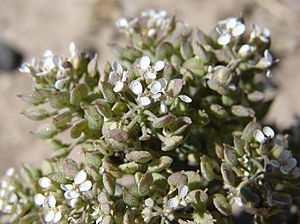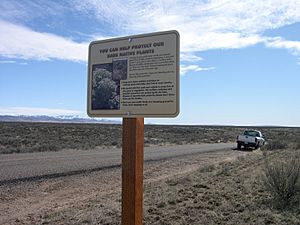Idaho pepperweed facts for kids
Quick facts for kids Idaho pepperweed |
|
|---|---|
 |
|
| Conservation status | |
| Scientific classification | |
| Genus: |
Lepidium
|
| Species: |
papilliferum
|
Lepidium papilliferum, also called Idaho pepperweed or slickspot peppergrass, is a special kind of flowering plant. It belongs to the mustard family. This rare plant grows only in Idaho, USA, mostly in the southwestern part of the state. In 2009, it was officially listed as a threatened species, meaning it needs protection.
Contents
What is Slickspot Peppergrass?
Slickspot peppergrass is a small plant, like an herb. It can grow from a few centimeters tall up to 20 centimeters, and sometimes even 40 centimeters. Its leaves are interesting because they are divided into many smaller parts, with the biggest parts being about 4 centimeters long.
Flowers and Fruit
This plant has many small, white flowers that grow in a cluster. After the flowers, it produces a unique fruit. This fruit is round, flat, and has small wings. It's very tiny, only about 3 or 4 millimeters long and wide.
Life Cycle
Slickspot peppergrass can grow in two ways:
- Annual form: This plant finishes its whole life cycle in just one year. It grows, flowers, and makes seeds all within that year.
- Biennial form: This plant takes two years to complete its life cycle. It grows leaves in the first year but doesn't produce flowers or seeds until its second year.
Where Does it Live?
This plant lives in a special environment called the sagebrush steppe ecosystem. This is a dry area with lots of sagebrush plants. Within this ecosystem, slickspot peppergrass grows in very specific spots called "slick spots."
What are Slick Spots?
Slick spots are small patches of soil that are different from the ground around them. They are often covered with a thin, living crust made of tiny organisms like cyanobacteria and algae. This is called a cryptogamic crust.
Slick spots have unique soil that is usually high in salt (sodium) and clay. They often look mostly bare, with not much other vegetation growing there. These spots are also slightly lower than the surrounding ground, so water tends to collect in them when it rains. The soil in slick spots is also lighter in color. When the water dries up, these areas become very dry.
How Slick Spots Formed
Slick spots take a very long time to form. Scientists believe that the slick spots we see today probably started forming thousands of years ago, during the Ice Age (the Pleistocene epoch). Later, in the early Holocene epoch, wind blew salt deposits onto these areas, which helped shape them.
It's thought that new slick spots are not forming in today's climate. This means that if a slick spot is destroyed, it's likely gone forever.
Why is it Threatened?
The number of slickspot peppergrass plants can change each year. If there is more rain in the spring, more plants tend to grow. However, overall, the total number of these plants has been going down over time.
Threats to its Habitat
The special slick spot habitat where this plant lives is being harmed by several things:
- Farming: Land used for agriculture can destroy slick spots.
- Grazing: Too much grazing by cattle can damage the delicate soil and plants.
- City Growth: New buildings and towns (urban development) take over the land.
- Wildfires: The number of wildfires is increasing in these areas. This is partly because of introduced plants like cheatgrass. Cheatgrass grows quickly and provides more fuel for fires, making them more frequent and intense.



